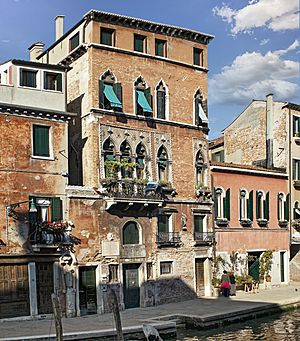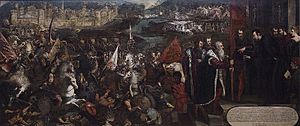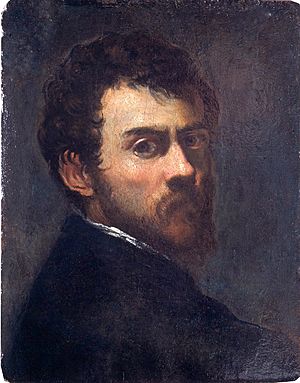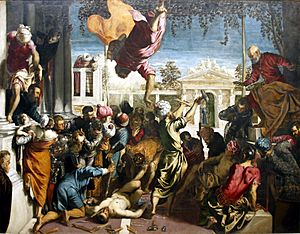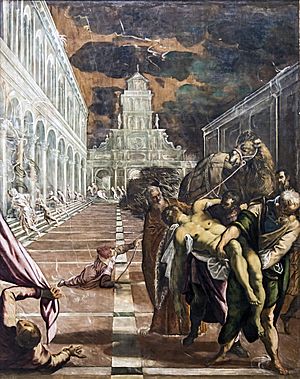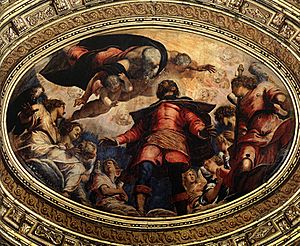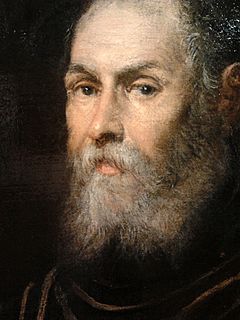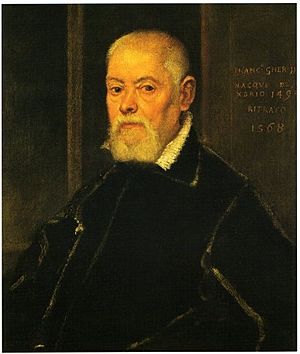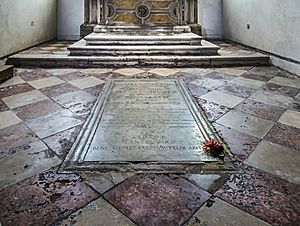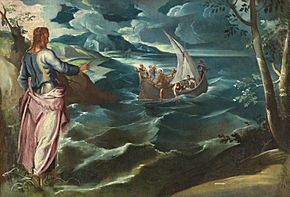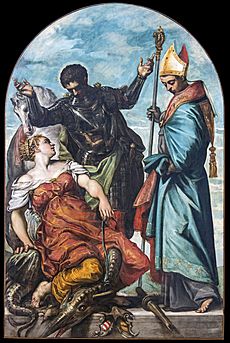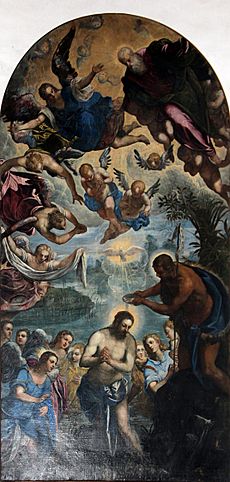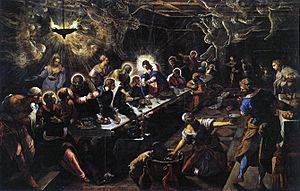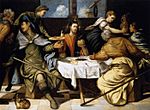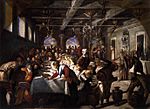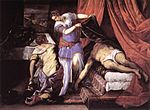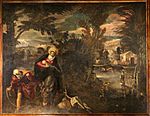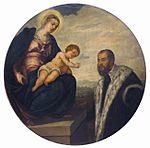Tintoretto facts for kids
Quick facts for kids
Tintoretto
|
|
|---|---|
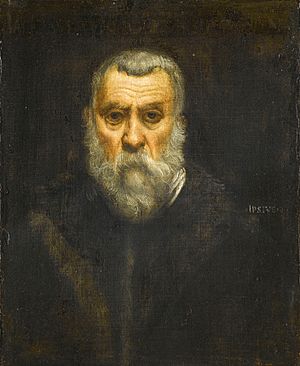
Self-portrait, c. 1588; Louvre, Paris
|
|
| Born |
Jacopo Robusti
Late September or early October 1518 |
| Died | 31 May 1594 (aged 75) Venice, Republic of Venice
|
| Nationality | Venetian |
| Known for | Painting |
| Movement | Renaissance, Mannerism, Venetian School |
Tintoretto (pronounced TIN-tuh-RET-oh) was a famous Italian painter. His real name was Jacopo Robusti. He was born in Venice in 1518. People admired and sometimes criticized how fast he painted. He was known for his bold brushstrokes. Because he painted with so much energy, he was called Il Furioso, which means "The Furious." His art often shows strong figures, dramatic movements, and cool ways of using perspective. He painted in the Mannerist style.
Contents
Life of Tintoretto
Becoming a Painter
Tintoretto was born in Venice in 1518. His father, Battista, was a dyer. A dyer is someone who colors cloth. Because of this, Jacopo got the nickname Tintoretto, which means "little dyer" or "dyer's boy."
We don't know much about Tintoretto's childhood or how he learned to paint. Some old stories say he briefly worked for the famous painter Titian. But he was quickly sent away. Some say Titian was jealous, others say they just didn't get along. After this, Tintoretto and Titian had a difficult relationship.
Tintoretto didn't seek more teachers. He studied art on his own with great effort. He practiced by drawing from live models and even studying human bodies. He collected sculptures and prints to learn from them. He often worked day and night. He wrote a goal above his studio: "Michelangelo's drawing and Titian's color." This showed his big dreams for his art.
Early Artworks
Tintoretto worked with another young painter named Andrea Schiavone. Tintoretto often painted for free to get his name out there. His first paintings that got noticed were a portrait of himself and his brother. These early works are now lost.
One of his early paintings you can still see is in a church in Venice. It's called Presentation of Jesus in the Temple (around 1542). He also painted for the Scuola della Trinità. Scuole were like clubs or charities in Venice, not schools. Two of these paintings, Adam and Eve and Death of Abel, are now in a museum in Venice. These show he was already a very skilled painter, even without much formal training.
For a long time, a painting called The Embarkation of St Helena in the Holy Land was thought to be by another artist. But in 2012, experts realized it was actually by Tintoretto! It's part of a series of three paintings about Saint Helena and the Holy Cross.
Famous Saint Mark Paintings
In 1548, Tintoretto got a big job: to paint a large picture for the Scuola di S. Marco. This painting was called Miracle of the Slave. He knew this was a huge chance to become a famous artist. The painting shows a slave who was saved by a miracle from Saint Mark. Tintoretto made the painting very dramatic, with unusual colors and strong brushstrokes.
The painting was a big success! Even though some people didn't like it, many did. Because of this success, Tintoretto got many more jobs. He painted Saint Roch Cures the Plague Victims (1549) for a church. This was one of his many "laterali" paintings. These were large, horizontal paintings for the side walls of chapels. Tintoretto painted them so they would look good when viewed from an angle.
Around 1560, Tintoretto married Faustina de Vescovi. They had many children. Three of his sons and four of his daughters lived to be adults. Before his marriage, he had another daughter named Marietta Robusti. Marietta, like her half-brothers Domenico and Marco, also became an artist.
Another famous painter, Paolo Veronese, came to Venice in 1551. Veronese started getting many important painting jobs. Tintoretto didn't want to be outdone. So, he offered to paint two huge pictures for his local church, the Madonna dell'Orto, just for the cost of the materials. He had already painted Presentation of the Virgin in the Temple (around 1556) for this church.
The two new paintings, Worship of the Golden Calf and Last Judgment, were very tall, about 14.5 meters (47 feet) high! They were painted around 1559–60. People loved them, and Tintoretto became known for finishing huge projects quickly and cheaply. After this, he often competed with other painters by working fast and for less money. Around 1564, he painted three more works for the Scuola di S. Marco.
Paintings for the Scuola di San Rocco
Between 1565 and 1588, Tintoretto created many paintings for the Scuola Grande di San Rocco. He won this job in a clever way. In 1564, four artists, including Tintoretto, were asked to submit a sketch for a ceiling painting. Instead of a sketch, Tintoretto painted the full-sized picture and secretly put it on the ceiling! He then said it was a gift. The rules of the Scuola meant they couldn't refuse a gift.
In 1565, he painted the Crucifixion for the Scuola. He continued to paint many more works there, sometimes for free or for very little money. He completed 52 paintings for the Scuola and the nearby church of San Rocco. These paintings are like huge, quick sketches, full of energy. They were made to be seen in the dim light of the building.
Tintoretto developed fast painting methods called prestezza. This allowed him to create many artworks, especially when he was working on big projects. Because of this, he painted more works for the Venetian government than any other artist of his time.
He also painted many works for the Doge's Palace. Many of these were destroyed in a fire in 1577. After the fire, he started again, working with Paolo Veronese. He painted many masterpieces for the palace, including battle scenes and mythological stories.
The Paradise Painting
The biggest painting of Tintoretto's life was the enormous Paradise for the Doge's Palace. It is about 9.1 by 22.6 meters (30 by 74 feet). It is thought to be the largest painting ever made on canvas. Tintoretto really wanted this job. He even told the senators he prayed to God to get it.
He competed with other artists for this important job. He made two large sketches for it. The final painting was given to Veronese and another artist first. But Veronese died before starting. So, the job went to Tintoretto. He worked very hard on it, making many changes and painting people directly from life.
When the painting was almost done, he moved it to the palace. His son Domenico and other assistants helped him finish it. Everyone in Venice loved the finished work. People said it was like seeing heaven with their own eyes. Tintoretto was asked to name his price, but he left it to the officials. He even took less money than they offered, showing he wasn't greedy.
Later Years and Legacy
After finishing Paradise, Tintoretto rested. He didn't take on any other big projects. He died on May 31, 1594, after being sick for two weeks. He was buried in the church of the Madonna dell'Orto. His favorite daughter, Marietta, who was also an artist, was buried there too. She had died in 1590 when she was only thirty. People say Tintoretto painted her last portrait as she lay dying.
Marietta was a very skilled portrait painter and musician. She often helped her father with his work, sometimes dressed as a boy.
Tintoretto didn't have many students. His two sons and Maerten de Vos were among them. His son Domenico often helped him with his big paintings. Domenico painted many works himself, but they are not as famous as his father's. The Greek painter El Greco, who lived in Spain, was likely influenced by Tintoretto's art after visiting Venice.
Tintoretto's Personality
Tintoretto rarely left Venice. People who wrote about him said he was smart and very ambitious. One writer said he "was always thinking of ways to make himself known as the most daring painter in the world." He loved all kinds of art. When he was young, he played music and even invented some instruments. He also designed costumes for plays.
He was a friendly person, but he mostly stayed in his studio to work. He kept his painting methods secret, sharing them only with his assistants. He was known for his clever and funny sayings, but he himself rarely smiled.
His wife made sure he dressed properly when he went out. She would even wrap money in a handkerchief for him and expect him to explain how he spent it. Tintoretto often said he gave it to the poor or to prisoners. He was friends with many writers and publishers, including Pietro Aretino, who helped him early in his career.
Tintoretto's Painting Style
Tintoretto's paintings are known for their bold brushstrokes. He used long strokes to show outlines and bright areas. His art shows the energy of people moving. He often used extreme angles and perspective to make his paintings more dramatic. The story in his paintings is shown through the figures' movements and energy, rather than just their faces.
One artist said Tintoretto could paint in two days what he could paint in two years! Another said Tintoretto was sometimes as good as Titian, and sometimes not. People in Venice used to say he had three pencils: one of gold, one of silver, and one of iron. This meant he could paint in many different ways.
Tintoretto's cleverness can be seen in paintings like Saint George, Saint Louis, and the Princess (1553). In this painting, the princess is riding the dragon and holding a whip! Saint George looks helpless, and his spear is broken. It's a funny and surprising twist on the usual story.
If you compare Tintoretto's The Last Supper with Leonardo da Vinci's famous painting of the same scene, you can see how art changed. Leonardo's painting is calm and balanced. Tintoretto's version is full of drama, with angels and a servant in the foreground. His use of light and strong perspective makes him seem like an artist ahead of his time.
Tintoretto painted many portraits. While some were done mostly by his assistants, his own portraits are often quiet and serious. Art experts have admired how well he painted older men. His self-portraits are also very famous. In his first self-portrait (around 1546–47), he looks very natural and direct. His second self-portrait (around 1588) shows him as an older artist, thinking about life.
Tintoretto's Legacy
In 2013, a museum announced that the painting The Embarkation of St Helena in the Holy Land was indeed by Tintoretto. This was an important discovery.
In 2019, to celebrate Tintoretto's birth, a big art show traveled to the United States for the first time. It featured nearly 50 of his paintings and many drawings. The exhibition showed his whole career, from portraits of rich Venetians to religious and mythological scenes.
Gallery
-
Judith and Holofernes (c. 1577), Prado Museum
See also
 In Spanish: Tintoretto para niños
In Spanish: Tintoretto para niños


